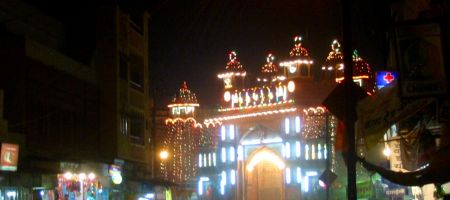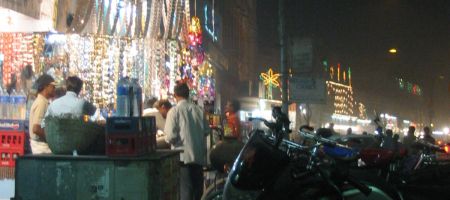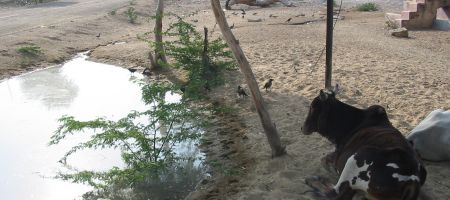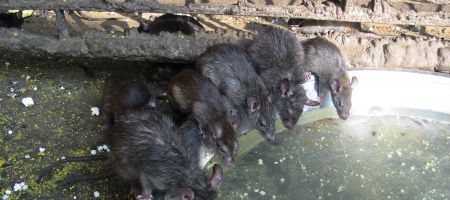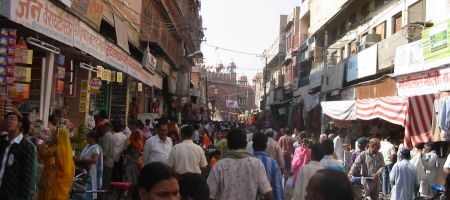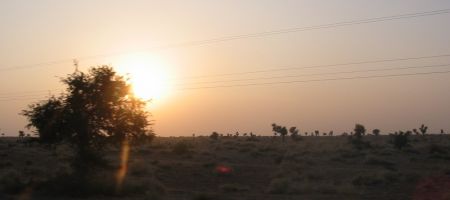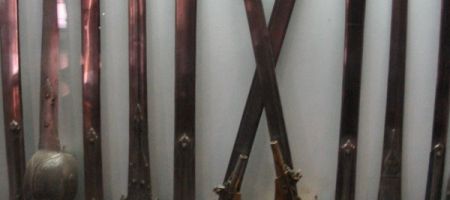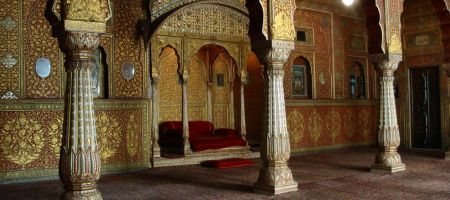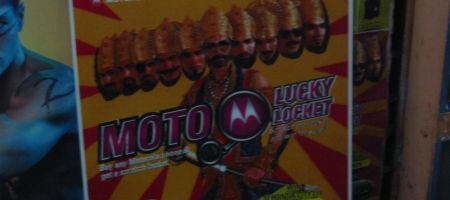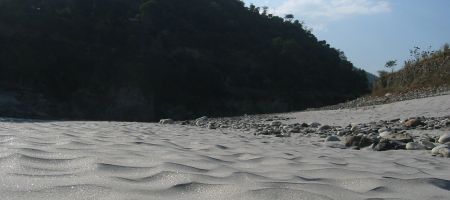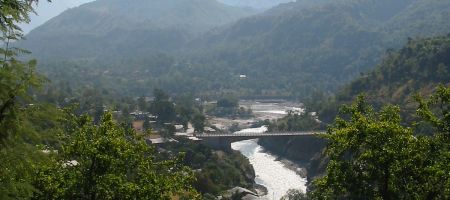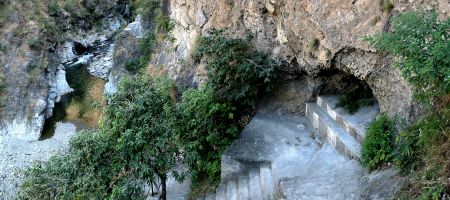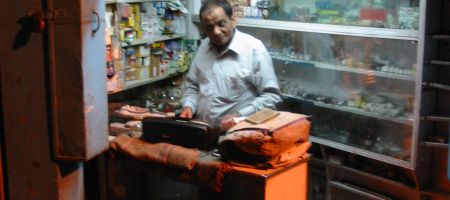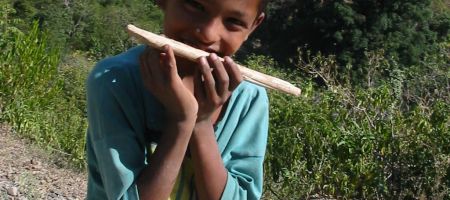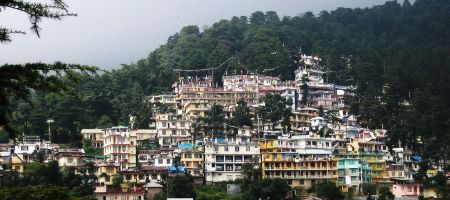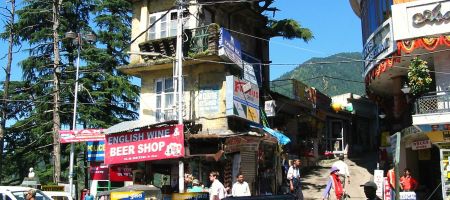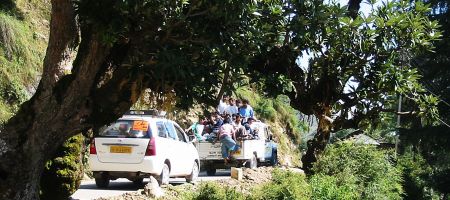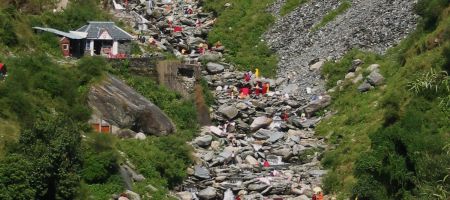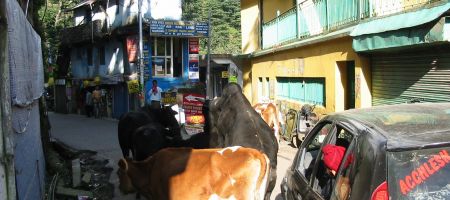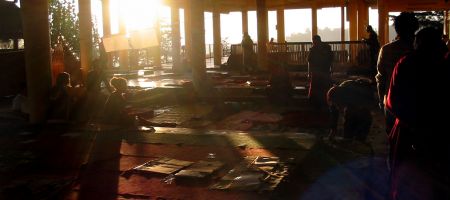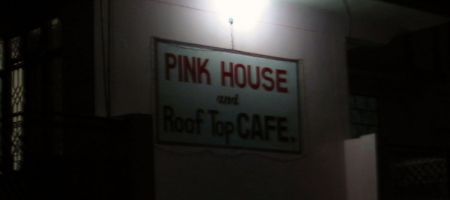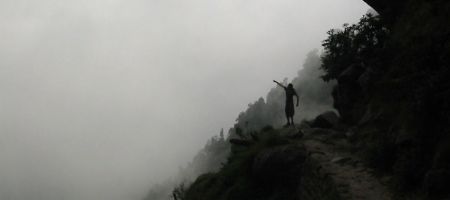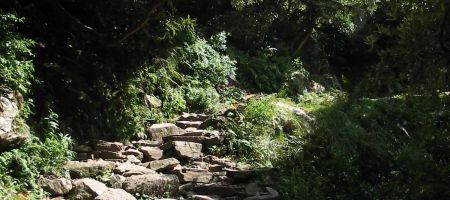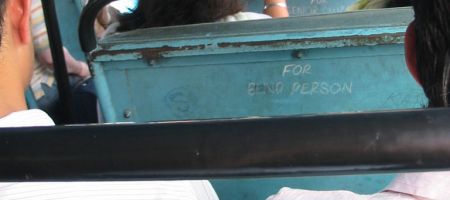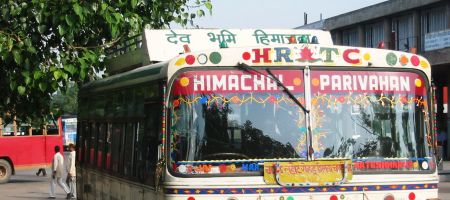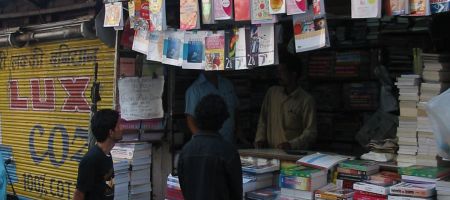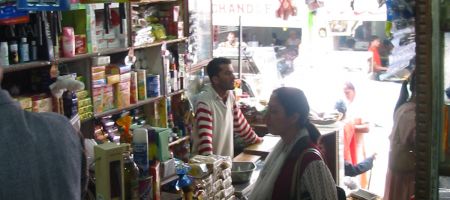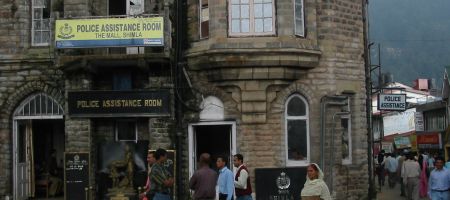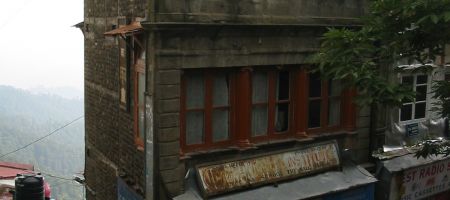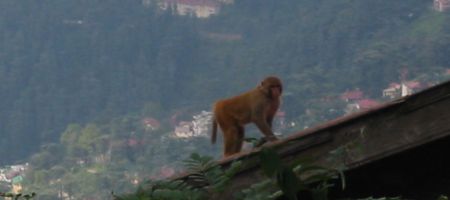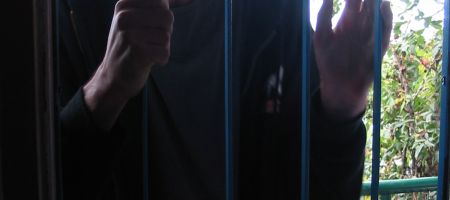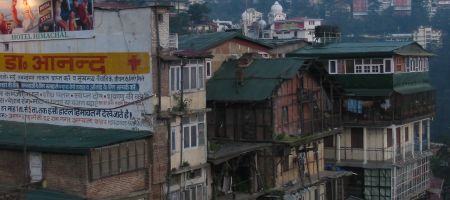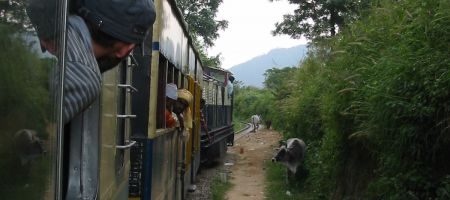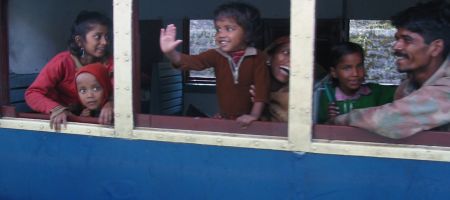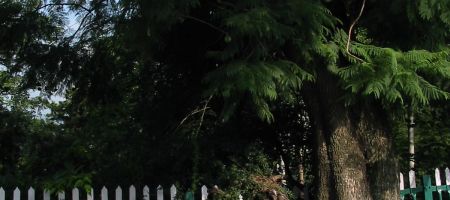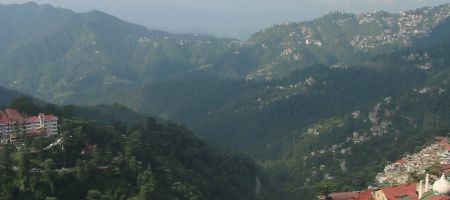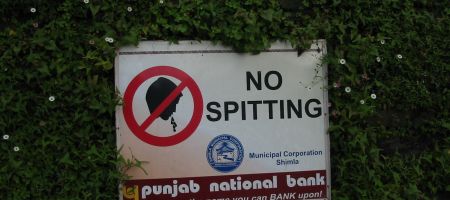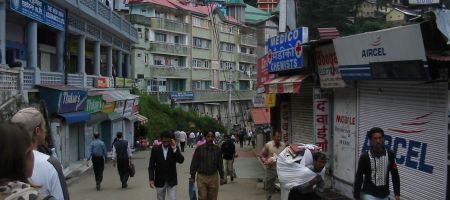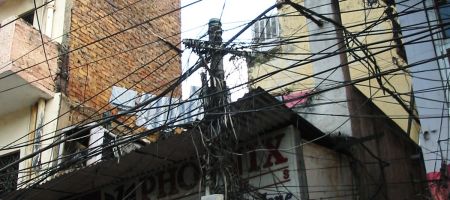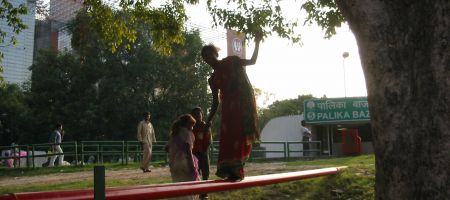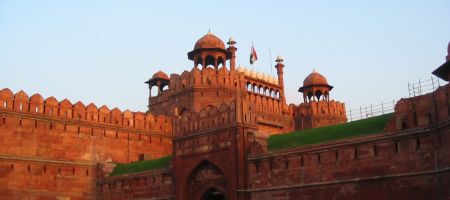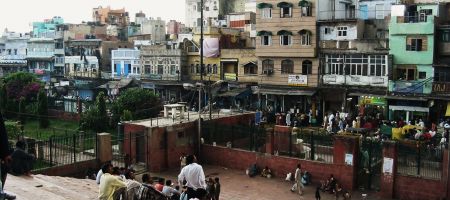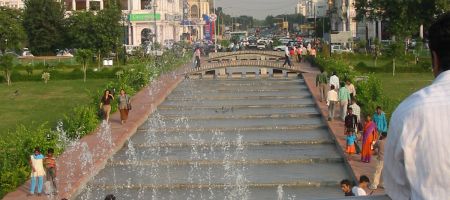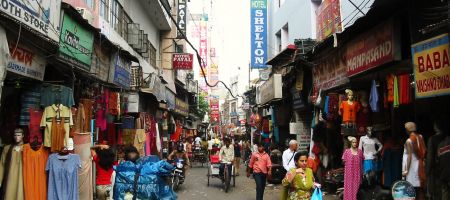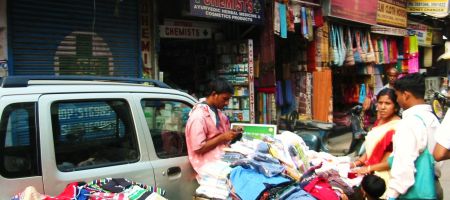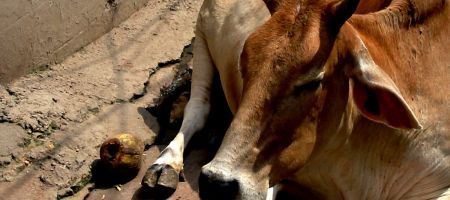Happy New Year!
Right now I sit in the nighttrain back from Bikaner, Rajasthan. I was there for just three days but got a lot of impressions and much to tell.1
On the 9th of November, Diwali was celebrated throughout India. Diwali, “The festival of lights”, is as important as for them as Christmas for us. It marks the victory of good over evil and the time when Rama came back home after defeating the evil ten-headed demon Ravana, King of Lanka (today: Sri Lanka). A week or so before Diwali, the Indians celebrate Dusshera, the Defeat of Ravana.
They built huge statues of Ravana and his evil demon sons out of cardboard, wood etc. and filled them up with firecrackers. In the evening, somebody dressed up as Rama would come and shoot burning arrows at the statues that were up to 20 meters high. Boom. :-D
According to the legend, Brahma granted Ravana the right to be not be able to be killed by any creature on earth (including the demigods). The demigods then pleaded to Vishnu to set an end to him, so Vishnu reincarnated himself as a human (Rama) to kill Ravana 2.
However, Diwali is celebrated with loads of fireworks, too. It’s basically like our Silvester in Germany but with more fireworks & firecrackers and more blinking light strings in all colors and sizes. And the market is as full of people as on the evening of the 23rd December.
I spent Diwali in Bikaner. Unfortunately, when it got dark and more and more kids started to blow up the streets and turned them into a sulphur pit, I got lost in the alleyways of Bikaner (again). So it was not so nice for me. But eventually, after lots of misdirections by locals, I found my way to an auto rickshaw.
Apropos legends and demigods:
Thirty kilometers from Bikaner there is a temple of a local demigod – Karniji. As I understood it, Karniji didn’t want that Death gets the people of her tribe – so villagers who died were directly reborn as rats and after that were reborn as members of the tribe, again.
So, the Karni matra temple is full of thousands of rats. However, I think this place looks pretty disgusting. The ground is not only full of rats but also full of leftovers and scraps, dead rats and shit. To have to enter that place without your shoes (which is common for Hindu temples) doesn’t make it any more pleasant. Overall, the rats don’t look any better and healthier than if they lived in a sewer. I really wonder why. Is it in the nature of rats, do they find against each other, …?
1 And I’d be really happy if more of you would start to give some feedback to it.
2 There is of course more to it than just this. The full story includes – amongst other things – that Ravana kidnapped Rama’s wife before, that’s why he attacked Lanka (Sounds familiar, eh?). But there is even much more to it. ;-) This is all part of the ancient Sanskrit epic called the Ramayana.

Tattapani
Tattapani is the name of a village in Himachal Pradesh. It’s located in a beautiful valley two hours north of Shimla (See Google maps or Google Earth KMZ file!). There are palmtrees all around and a crystal clear turquoise but rapid river goes through the valley. There are many beaches stretching at the river that offer an amazing view. Overall, it looks very tropical.1
Anyhow, I only reached Tattapani by pure chance. I originally wanted to go to the Kullu valley but as it turned out, when I finally reached Shimla, I had not enough time to get there. Because I only wanted to wander in the mountains, I just got on the next bus that was going to some valleys and villages around Shimla.
It is amazing how many people can travel with a bus with just 20 seats: I counted 80. (About 20 on the roof) :D
The Lonely Planet has just a quarter of a page to say about this village but it is a really nice place to hang about for a few days. I stayed at spring view hotel which is directly at one beach and has it’s own hot sulphur springs just next to the hotel. The owner of the hotel organizes small rafting tours, too. I didn’t do that but on the next weekend in Rishikesh. Instead, I walked to the Shiva cave (about 2 hrs up the mountains if you walk slowly).
The cave was not that interesting, there was just one old guru living in the cave who murmured prayers (I guess) all the time and rebukes strangers that enter with their shoes on. He was looking so grumpy that I didn’t dare to disturb him in his prayers by making a photo of his appearance.
But it was fun to communicate with some farmer girls I met at the small stream near the cave. I couldn’t speak any Hindi and one only spoke very basic English… a pen and a big notebook are really worth gold. :-)
1 which is not normal in Himachal Pradesh. The landscape there more reminds one of the Alps and Austria.
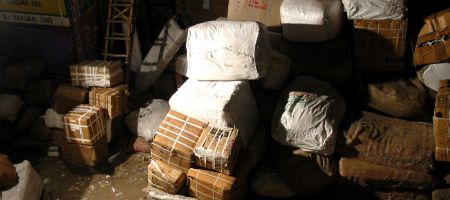 This is how parcels are stored in Shimla (outdoors). So, Clonkonaut, Mad… if the letters aren’t there yet, perhaps they are in that tire over there? Who knows :-\
This is how parcels are stored in Shimla (outdoors). So, Clonkonaut, Mad… if the letters aren’t there yet, perhaps they are in that tire over there? Who knows :-\Comment [1]

For freedom fighter
The title sounds familiar? Right, I’m writing about buses again!
I have the impression that I didn’t make myself clear about buses in the last post because it’s hard to imagine that some buses actually go faster than the rest of the traffic. But I tell you, some buses drive originally like in a Hollywood action movie here…
I got on one of those Shimla to Chandigarh buses again and I nearly laughed all the time. Imagine the scene: Bruce Willis jumps into a taxi, shouting “Follow that car over there!”. At least the next ten minutes of the film are usually devoted to a long chase, including awesome speeds and stunts, many (nearly) accidents, squealing tires and a lot of shouting and much cursing.
Well, just this taxi would have been either overtaken by or more probably rammed away by that Indian bus. He did not care at all – just during the ten minutes I was on that bus, the driver nearly ran over two bicycles while running the redlight and drove about 70-100 km/h in the city. Other cars were just bluntly shooed away with light horn, real horn and many curses. Of course, they quickly hurried out of the way.
Some minutes, a police car with sirene on drove besides the bus, trying to get faster through the city than the bus….
All in vain (but OK, sirenes are not so well respected here). Eventually, we lost the police car. I guess it could have been faster if it had driven just behind this bus.
And I got home in record time :-)
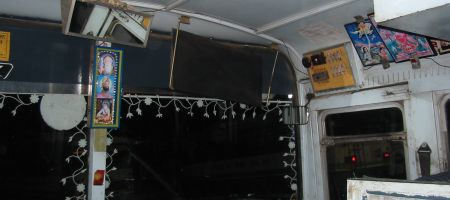 The “cockpit” of a govt. bus. From left to right: Sikh religion symbol and window decorations, an image of three Sikh gurus with blinkenlights (red-green), incense-sticks (green box), steering wheel and more window decorations, fuse box (top) and images of favourite Hindu gods (better seen on the first image)
The “cockpit” of a govt. bus. From left to right: Sikh religion symbol and window decorations, an image of three Sikh gurus with blinkenlights (red-green), incense-sticks (green box), steering wheel and more window decorations, fuse box (top) and images of favourite Hindu gods (better seen on the first image)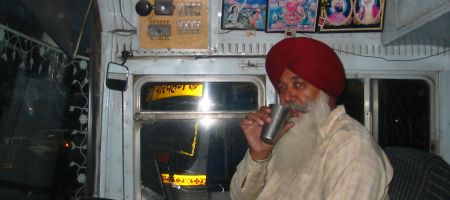 The driver (Sikh). Note the long arm of Vishnu, hihi :-). Can somebody tell me the story behind this image? The middle image shows Durga, a warrior goddess and the right one two Sikh gurus.
The driver (Sikh). Note the long arm of Vishnu, hihi :-). Can somebody tell me the story behind this image? The middle image shows Durga, a warrior goddess and the right one two Sikh gurus.Comment [2]

About advices
Now, this has less to do with India but I started thinking about this when I considered whether or not I should give advices to the lads that will visit me in India in March and if yes, which. There is certainly enough to warn about in India but I decided to not give any advices that go further than telling solely about my experiences, nothing in a “do” or “don’t” manner. And I’ll tell you why:
First, I don’t like to receive advices like this for myself because it takes away my freedom of choice and own consideration. I can only either decide to refuse to act according to that advice or to conform to that advice. Of course there is justification for those kind of advices in most cases but they offer only a very limited and refined view of the true situation. Just think about how an advice comes together:
It’s just the experience of one person who interpreted the situation in his certain way and eventually learned a lesson. When he makes an advice out of it, he tries to generalize this experience and the lesson he learned – including his values, opinions and views – for everyone. He cuts out possible other experiences and most importantly even the experience itself! Moreover, he doesn’t take into account that the advice may not applicable for everyone. For example “Drink more milk (because it is healthy)” is clearly not applicable for everyone. (Especially not me ;-) )
Some advices are even passed on. So, when you hear an advice that has been passed on like “Don’t eat raw vegetables in India” and ask for the reason why, the person who told you (and only heard and followed that advice by himself) will make up something reasonable to not loose his face, for sure. (So, the answer would be that “raw vegetables are full of germs, bugs and/or diseases there, obviously”).
It is fatal to leave out the actual experience because what is left then is just a command. It leaves the person who follows it unexperienced and dependent, limited in his view. Even if you just hear an advice without actively following it, you will still be biased because you have this in mind in these situations.
So, as a conclusion, I think those kind of advices have more in common with a command than actually honestly sharing an experience. However there are sometimes situations where even I appreciate those kind of advices from people I trust – when I just can’t decide about something. :-)
I heard so many advices from AIESECers, co-workers and my boss since I am here, people of I am sure that they just want the best for me and have some experience. Some said I shouldn’t trust strangers, I was told not to buy any food from the road because it is unhygienic, to not go to those tree-barbershops because of the same reason, not take a bath in the Ganges, not travel on the roof of a bus and never never hitchhike… Been there, done that. I know, these advices are just meant well, but sometimes I wonder if the they go sometimes even out of their houses?
Overall, I value my common sense, my cautiousness and own perception over advices like this and I advice everyone to do the same ;-).
“Be careful whose advice you buy, but be patient with those who supply it. Advice is a form of nostalgia; dispensing it is a way of wishing the past from the disposal—wiping it off, painting over the ugly parts, and recycling it for more than it’s worth.”
- Baz Luhrman in the song “Everybody is free to wear sunscreen”. See Lyrics.
Comment [1]

High in the mountains
I got an extra long weekend off because of Gandhi’s birthday and because I took a leave for one day. I originally wanted to go for trekking in Kinnaur-valley but the others didn’t want to travel fifteen hours in an ordinary (local) bus over night.
So, after an exhausting eight hours journey still on an ordinary bus from Chandigarh into the Himalayas, we finally reached Upper Daramshalah, also known as Mcleod Ganj. Mcleod Ganj is the residence of the exile government of Tibet and the Dalai Lama. Since the Chinese invaded and built up a brutal military regime in Tibet, destroyed most Bhuddist monasteries by now and killed hundred thousands, many Tibetians fled to this place and other places in Himachal Pradesh since then.
Anyway, Mcleod Ganj is not a refugee camp but a really pleasant Tibetian community. Because of that, Mcleod Ganj is and has been a favourite destination for Western backpackers and yogis as much as Bhuddist monks. It’s a really relaxing athmosphere here, many tourists attend meditation, yoga, reiki or any other kind of spiritual fu here. You can get massages, buy funny esotheric books and artifacts here or just sit in a cafe, enjoy the great view and drink a nice cup of masala tea.1
It’s really very touristy here but I think it affected this town in a good way. Of course, all have more money now, but this is not what I mean: I believe, many esotheric and spiritual practices spread in the Western world claim to be originated in spiritual and religious places like Mcleod Ganj or Rishikesh. After all, India, Tibet, Himalayas etc. sound very exotic and mysterious if you are far away and don’t know how it is really there. You suspect, you begin to believe.2
So, many tourists come here with the expectation of this being a shrine, a source of spiritualism, a point where it all comes together… thats why you find exactly this here.
The Western people seeking for spiritual salvation are influencing the culture here to something they (or we) expect. A place to hang out, have a joint, attend courses (“learn X in 5 days”) and get a nice sip of spiritualism. It is really nice here and I wish I could have stayed longer to actually do all this stuff. I just should keep in mind, that this town is different from what you would experience as spiritualism in other places in India.
But this is just my first impression, I got no big insights in that.
Anyway, I couldn’t help but buy cool spiritual stuff there, get some funny clothing, a massage and do some sightseeing of course.
On the last day there, I went to the mountains with John.
The views were plainly awesome! There were actual clouds climbing up the mountains besides us.
1 a tea out of a mix of Indian spices like ginger and cinnamon, it’s sweetened with a lot of sugar and milk
2 The wizards of the disc world are somewhat nonreligious: They don’t believe in the gods at all. They do not deny that they exist but you see, they don’t believe in the postman neither. The postman is just there as much as the gods – and sometimes they come to have dinner. They don’t believe because they know them personally.
Comment [3]

Midtown madness
So, after spending 1 week in Chandigarh, I bought a new bike (for 2000 Rs)! It’s a classical Indian bike – no light, no gear shift – but it’s ok. Of course, you have to look out and be cautious all the time in this kind of traffic: Bicycles are at the lower end of the traffic hierarchy. Even after rickshaws and horse powered carriages since they are slower and bigger. Other vehicles try to get attention by horning all the time. It’s always a fight who will make it’s way faster through the streets.
But nobody can horn away local buses. They are at the top of the food-chain of traffic: They are big, they got heavy load and they drive fast as hell. Trucks are pretty big, too, but are not driving quite as adventurous and fast – at least while they are not on the highway.
By owning an own bike here, I at least don’t have to bargain with all those annoying rickshaw drivers when I want to go somewhere. It is really a good feeling of freedom. They charge you extra when you are white and refuse to understand “no” or even “nahin”.1
However, I’d need one hour to get from home to work with the bike, so I don’t want to rely on my bike for that.
Surprisingly, the public transportation system is nearly able to handle the amount of people here. Only few buses are so full that the people hang out of the entrances (the buses have no doors). The only really bad thing about ordinary local buses is the legroom: There is not even no legroom, there is a negative amount of legroom. At least for people my size.
Also, the buses don’t really stop on bus stops, so one should be prepared to hop on (or off) a moving bus. :)
When I first sat down in a local bus, I saw a writing on the back of one seat bench that said “For handicapped person”. OK, nice. But when I further looked around, about half the bus was reserved for several minorities and majorities (low-key)! Some more were reserved for handicapped persons, then about two seat banks “for blind person”, some for “senior citizen”, some more for “middle-aged woman” and even some for “freedom fighter”! Whoever this is and how he is recognized! :D
What I first thought of being a joke or the work of an over-ambitious employee, can actually be found on all buses.
One day I stayed in the office till 9:45 PM and was shocked to see that I missed the last bus back into Chandigarh2. OK, there was one auto rickshaw driver standing at the bus stop but I knew he would charge me much extra because first of all I’m white and second I looked desperate. Well, he wanted about three times of the fair price from me and was not trying to bargain with me. It was not soo much money (100 Rs) but this was about my principles! So, I just walked away.
But then I realized that I really was desperate and it would take 2, up to 3 hours to walk home – partly through slums. Near to the next traffic light, a local was standing besides the street and I asked him where he wants to go. He simply replied that he’ll go to ISBT (main bus station, my destination). “What? I read that the last bus to Chandigarh is already gone, how will you manage to get there?”. He told me that I was right, no local bus is driving to Chandigarh anymore but this is the road where the long route buses from Shimla ISBT to Chandigarh ISBT drive by and he will just hop into the bus while the bus stops at the red traffic lights. And he was right, after some minutes, a bus came, we run a bit and got on the bus. And paid just 5 Rs, the standard bus fee :]
This was a little adventure but now I’m using that opportunity more and more since those long route buses go directly to ISBT and are therefore a lot faster :)
1 The standard dialogue goes like this (if you don’t ignore them): “Rickshaw rickshaw?” – “Nahin” – “Hotel? Cheap? I take you!” – “Nahin!..” – “Go to Mohali?” – “No!.. look! I just want to go to the bus station over there!” – “OK. Manimadja? Rock Garden? Hotel?” – “No! I live here, I just want… ah, fuck you”. By that time, you should be rounded up by about five other rickshaw drivers then. ;)
2My office is outside Chandigarh and I need nearly one hour to reach it with public transportation.
Comment [1]

Monkeying around
It’s odd to see all the monkeys running and climbing around on the rooftops. You know, in Germany, I considered street dogs as very dangerous. Well, in India, even in the heart of Shimla, there are lots and lots of street dogs. And all they ever do is sleep all the day. Only to fight each other, bark and howl all night to keep you from getting any sleep. Grr, I could kill them! But they are “considered harmless”.
Well, the monkeys are not. I guess it was more dangerous than I thought when I walked besides a monkey down a road one day for some minutes ^^.
There is a temple of a god nearby that is in some way connected to monkeys. If I remember correctly, the monkeys are supposed to be the reincarnation of the priests of this god. However, at this temple, there are supposed to be lots of err, priests. Actually, they are so aggressive that they’d steal your glasses and cameras, try to get into your backpacks to search for fruits etc. I’ll definitely go there some time, but while I was there, there was no time left to climb up to that temple. Instead, I went to the place from where India was ruled during the summer.
But here, have a look at some photos: ;)

Shimla
OK, had really much stuff to do plus was ill this week. So I got no time to update this blog. Anyway, I spent only two days in Delhi. After Delhi, I joined some other travellers on the journey to Shimla and stayed there for three days before I went to Chandigarh. Shimla was the summer capital of British India. Because of the searing heat in Delhi during summer, the government officials packed up all their paperwork and fled to the temperate climate in Himachal Pradesh. In winter, there is snow all around. Himachal Pradesh is the home of the Dalai Lama and the neighbouring region to Nepal.
We got up at 5 am to catch the train to Shimla. I guess I don’t even have to mention that the New Delhi railway station is a mess and way too crowded1. We even nearly got on the wrong train because the train to Shimla arrived at another platform than it was announced.
The train from Kalka took about five hours to arrive in Shimla – on a height of nearly 2000 metres. But the travel was worth while: By that time we had gone through 102 tunnels and had seen beautiful views of the Himalaya, the nature and all. After Delhi, this relaxing journey was exactly the kind of thing I needed.
Compared to Delhi, you really feel like on a vacation in Shimla. The city centre consists of British well maintained colonial architecture and there is even a christ church here. The shops appear to be pretty Western, too.
Actually, Shimla is a popular target for Indian tourists. Shimla is also known as the honey-moon city. For Indians, modern, rich and lifestyle all means Western culture. For example fast food restaurants compete with local noble restaurants, not with local snack bars. So, when you switch on Indian TV, don’t be surprised when you see nearly everyone wearing western clothes and having an – for Indians – unusually light colour of the skin.
So, beggars here are somehow kept away from the streets, salesmen don’t come rushing towards you, it’s tidy (at least a the mall, the city centre) and quiet because there are no cars or rickshaws allowed here.
We stayed at a YMCA (yes, the one from the song :-) ) which was a huge old mansion with a big ballroom, reception room and so on. Exactly that kind of mansion you’d expect to have a dark secret2. But in this case it was not really a secret ;-P.
1 because this applies to whole Delhi
2 like it has been built on an Indian sanctury, it has been the home of a mass murderer who then killed his own family or something equally horrible
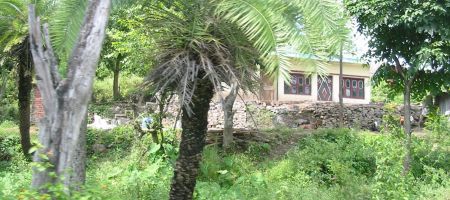 Now this looks exotic. But don’t get the wrong impression: Himachal Pradesh and Austria look surprisingly alike. Just more poverty plus some palms. This is the only exotic photo I got from the journey.
Now this looks exotic. But don’t get the wrong impression: Himachal Pradesh and Austria look surprisingly alike. Just more poverty plus some palms. This is the only exotic photo I got from the journey.
Been sightseen
Me and Julia were off doing a bit of sightseeing and exploring the city.
The architecture of Delhi looks very… special because the buildings have been growing with the time. It looks like they actually built several houses or huts on top of each other. They look really horrid (from the view of an architect), too. But they seem to have at least the stability to remain on top of each other.
But in Old Delhi, it looks so bad that I wonder why it doesn’t all collapse. Old Delhi is really frightening. The poverty seems to be even more extreme there.
I visited the Red Fort and India’s biggest mosque, the Jama Majd. I’ve never been to a mosque before but it was really nice there. Joerdis pointed out, that a mosque appears to be much more than a place to pray. It’s more of a social meeting point, to meet friends and family, talk, take a nap and so on. I totally agree with her.
However, when I was there with Julia, I got the impression that we were the real attraction for the locals. Kids were running after us all the time and wanted photos with us. After all, we were one blond woman and a tall man with long hair and a metal-t-shirt from Germany. I guess we looked really exotic to them.
New Delhi is quite the opposite of Old Delhi. Connaught place has nice bits of British colonial architecture, even though there isn’t much left because the Indians just have no sense for maintenance ;-). The streets are broad, the cars drive more or less in order an you can actually walk on the pavement! The shops are pretty Western and they got a nice park in the middle. There are even people with brooms who are employed to sweep the pavements. And that’s what they do. They actually shove the waste from the pavement on to the street! This kind of waste disposal may look odd for us, but is pretty logical in a city without any(?) garbage cans: Their standard method of getting rid of garbage is to put it somewhere else.
Comment [3]

Please mind the gap
I originally planned to stay just one day in Delhi but I decided to stay a bit longer in this frightening city.
You know, you can’t imagine a developing country if you’ve never been in one. Everything is different, you get an impression on how else a society can (or cannot) work. For example before I arrived, I thought there would be at least some supermarkets around or a real public transportation system. Hahaha, how naive ;-)
The streets here are dirty, traffic lights do not exist and if there are pavements, you can’t walk on them because these are actually the living rooms of other people (as Lena put it) 1, there are just merchants, beggars or sleeping street dogs.
So, you basically share the street with those rickshaws, auto-rickshaws, cars that sound their horn all the time to push forward (like everyone else). the traffic situation is even worsened by all these docile cows that stand on the overcrowded, loud and dirty streets. This often leads to a traffic jam. It’s rush hour all day long. Local busses don’t really halt at bus stops, you just hop on or off while they move slowly or are stuck in a traffic jam :-).
You know, if too get too close to a seller, they will immediately praise their wares and you are pushed to buy something. Hence, the first two words I learned in Hindi were “Nahin” (“No!”) and “Chalo” (“Go away!”). ‘Cause as soon as you start to talk with beggars, sellers, ambitious rickshaw drivers 2, it’s really hard to get rid of them. Especially the child-beggars are stubborn as hell.
There are taunts and thieves, too. Often, it’s just shortchanging or about them claiming to have no change money 3. Bargaining for a rickshaw or taxi ride is standard and it’s standard that it’s overpriced if you don’t bargain at all before you enter. After all, Delhi is not that dangerous, you can protect yourself from most taunts if you keep being friendly but cautious towards strangers and put your valuables somewhere safe. Many Indians are really that curious about you and are just being polite, others life from that. They look up to the western culture.
Delhi has a metro, too. It’s very new and is utterly disturbing me. First, I didn’t realize why, but then it struck me: This place is clean, quiet, it doesn’t smell here 4, no beggars running around, no cattle or street dogs, no sellers, rickshaw drivers and it’s even less crowded here. I was totally reminded of Western cities, clean and modern. It kinda didn’t belong there.
So, everything what Delhi actually is, is stripped off here. Without all this, they just look like people wearing interesting clothes.
This whole thing looks like a try to domesticate Indians to Western standards. Those who planned the metro really thought about how to teach Indians the way to use a metro. They even drew lines on how to exit and how to enter. Well, it doesn’t work, they still enter and exit all at the same time and in no order. I watched a family trying to get on an escalated staircase. It looked like they were doing a stunt or something :-)
1 but without furniture
2 “Where you wanna go? I take you whole city! Wanna go to Connaught Place? Where you …” and so on ;-)
3 after you paid of course
4 Only then when I smelled the absence of smell, I realized that Delhi smells really bad
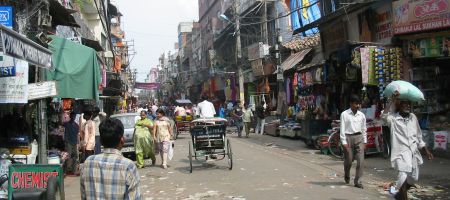 A typical scene from the street. Actually, it looks like that everywhere, not only at bazar streets.
A typical scene from the street. Actually, it looks like that everywhere, not only at bazar streets.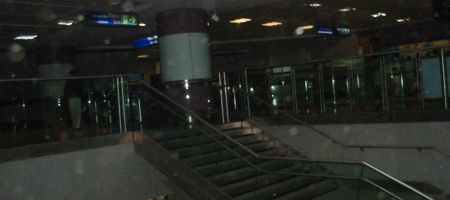 One photo from the metro station. This is the only photo I could make before one of the soldiers warned me to not take any photos for it is forbidden. The security
One photo from the metro station. This is the only photo I could make before one of the soldiers warned me to not take any photos for it is forbidden. The security 

